 |
| Blooming Paperwhite Narcissus |
 |
| Loose Paperwhite bulbs |
There may be a chill outside but that doesn't mean you can't plant some flowers indoors. The solution: Paperwhites. I have posted on this topic a few times in winters past. This is so easy that I can't think of any reason on earth why you wouldn't want to do it. I'm going to recap the main steps here, but for more pictures, you can go to my previous posts: Winter Blooms and Flowers in Winter.
1) In many of the discount chain stores, you'll see paperwhites in kits. You can buy those, but I like using my own containers so I buy my bulbs loose at my local big box store or nursery. You decide what you prefer. More than likely, the label will say something like Paperwhite "Ziva".
 |
| Paperwhites planted in rocks and water |
2) Put soil or rocks in a container. For once, you will not need (or want) drainage holes in your container.
3) If using soil, dampen it a bit but don't soak it. If using rocks, bring the water level up to the top level of the rocks.
4) Place bulbs root-side down on damp soil or, if using rocks, on the surface of the rocks so that a little water comes in contact with the roots.
 |
| Paperwhites sprouting in soil |
5) Put container indoors in any place where it will get at least medium light.
6) Keep soil damp (not wet) or water level of rocks in contact with bulb roots.7) Wait about 3 weeks for stems to start growing and blooms to appear.
Be aware that most paperwhites will have a scent. Some people love it (me), some people hate it (the husband of the lady who I encountered at the nursery a couple of years ago). My local nursery started stocking individual bulbs that produce unscented blooms.
I have more to say about bulbs in winter, but I'll talk about that in future posts.
 |
| Close up of Paperwhite blooms |
Bookshelf: Container Gardening Books

































